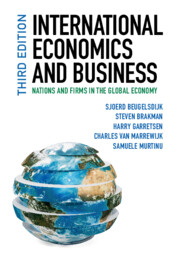240 results
Part I - Introduction
-
- Book:
- International Economics and Business
- Published online:
- 21 December 2023
- Print publication:
- 21 December 2023, pp 1-74
-
- Chapter
- Export citation
4 - Trade and Firm Competition
- from Part II - International Competition
-
- Book:
- International Economics and Business
- Published online:
- 21 December 2023
- Print publication:
- 21 December 2023, pp 102-127
-
- Chapter
- Export citation
References
-
- Book:
- International Economics and Business
- Published online:
- 21 December 2023
- Print publication:
- 21 December 2023, pp 265-279
-
- Chapter
- Export citation
Copyright page
-
- Book:
- International Economics and Business
- Published online:
- 21 December 2023
- Print publication:
- 21 December 2023, pp iv-iv
-
- Chapter
- Export citation
9 - Risks, Crises, and International Firms
- from Part III - International Organisation
-
- Book:
- International Economics and Business
- Published online:
- 21 December 2023
- Print publication:
- 21 December 2023, pp 239-264
-
- Chapter
- Export citation
8 - Managing across Borders
- from Part III - International Organisation
-
- Book:
- International Economics and Business
- Published online:
- 21 December 2023
- Print publication:
- 21 December 2023, pp 218-238
-
- Chapter
- Export citation
3 - Trade, Comparative Advantage and Technology
- from Part II - International Competition
-
- Book:
- International Economics and Business
- Published online:
- 21 December 2023
- Print publication:
- 21 December 2023, pp 77-101
-
- Chapter
- Export citation
Preface to the Third Edition
-
- Book:
- International Economics and Business
- Published online:
- 21 December 2023
- Print publication:
- 21 December 2023, pp ix-xiv
-
- Chapter
- Export citation
Part III - International Organisation
-
- Book:
- International Economics and Business
- Published online:
- 21 December 2023
- Print publication:
- 21 December 2023, pp 189-264
-
- Chapter
- Export citation
Author Index
-
- Book:
- International Economics and Business
- Published online:
- 21 December 2023
- Print publication:
- 21 December 2023, pp 280-282
-
- Chapter
- Export citation
Subject Index
-
- Book:
- International Economics and Business
- Published online:
- 21 December 2023
- Print publication:
- 21 December 2023, pp 283-287
-
- Chapter
- Export citation
Contents
-
- Book:
- International Economics and Business
- Published online:
- 21 December 2023
- Print publication:
- 21 December 2023, pp v-viii
-
- Chapter
- Export citation
6 - The Liability of Distance and Foreignness
- from Part II - International Competition
-
- Book:
- International Economics and Business
- Published online:
- 21 December 2023
- Print publication:
- 21 December 2023, pp 153-188
-
- Chapter
- Export citation

International Economics and Business
- Nations and Firms in the Global Economy
-
- Published online:
- 21 December 2023
- Print publication:
- 21 December 2023
-
- Textbook
- Export citation
7 - Global Value Chains
- from Part III - International Organisation
-
- Book:
- International Economics and Business
- Published online:
- 21 December 2023
- Print publication:
- 21 December 2023, pp 191-217
-
- Chapter
- Export citation
2 - Nations and Firms
- from Part I - Introduction
-
- Book:
- International Economics and Business
- Published online:
- 21 December 2023
- Print publication:
- 21 December 2023, pp 41-74
-
- Chapter
- Export citation
Part II - International Competition
-
- Book:
- International Economics and Business
- Published online:
- 21 December 2023
- Print publication:
- 21 December 2023, pp 75-188
-
- Chapter
- Export citation
1 - The Global Economy
- from Part I - Introduction
-
- Book:
- International Economics and Business
- Published online:
- 21 December 2023
- Print publication:
- 21 December 2023, pp 3-40
-
- Chapter
- Export citation
5 - Firms and the Structure of Trade
- from Part II - International Competition
-
- Book:
- International Economics and Business
- Published online:
- 21 December 2023
- Print publication:
- 21 December 2023, pp 128-152
-
- Chapter
- Export citation
TECHNICAL NOTE 18.1 - FIRM REVENUE AND PROFITS
- from 18 - Heterogeneous and Multinational Firms
-
- Book:
- The Economics of Developing and Emerging Markets
- Published online:
- 16 December 2022
- Print publication:
- 01 December 2022, pp 479-479
-
- Chapter
- Export citation



